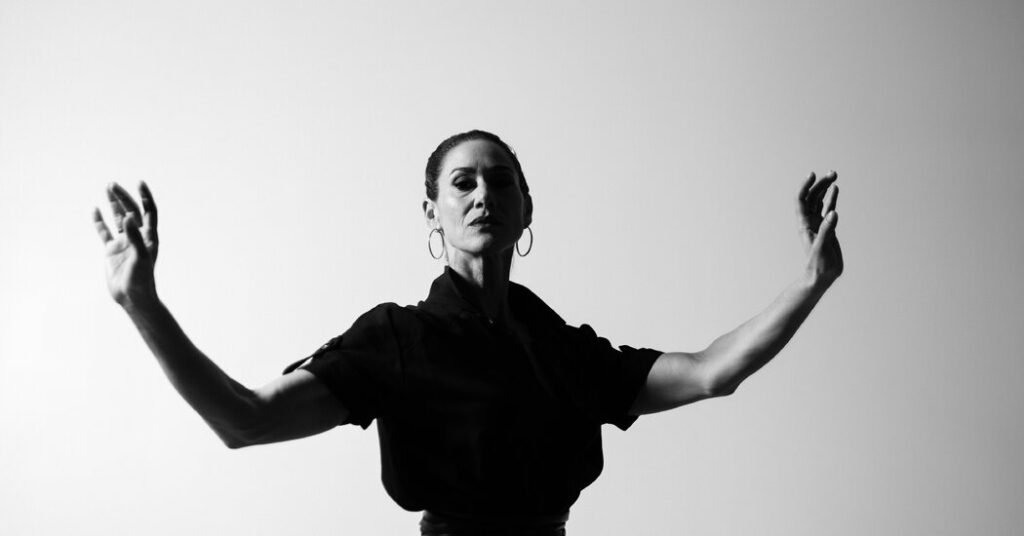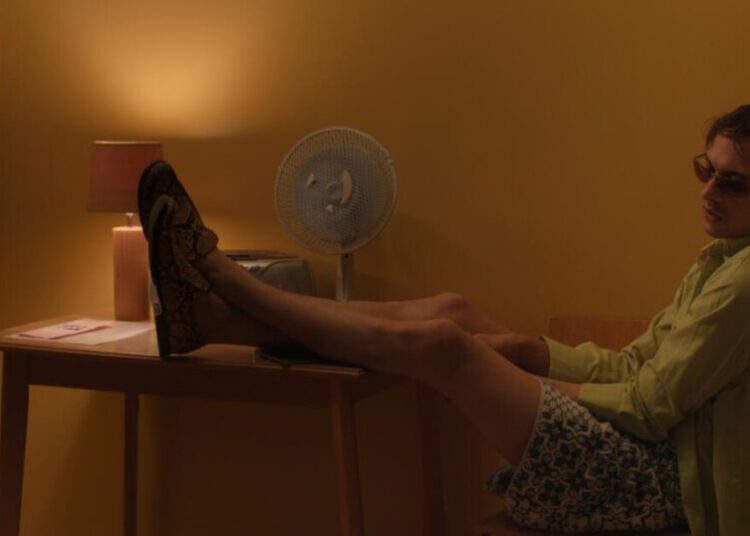The goddess of love drifts in on waves and wind. When the choreographer Maija García was invited to make her first work for Alvin Ailey American Dance Theater, this was the first image that came to mind.
Then, a colleague directed her to “Black Gods, Green Islands,” a collection of Afro-Caribbean folklore written by Geoffrey Holder, the Trinidad-born artist, actor and dancer. The final story, “Goddess,” opens with almost the same image as the one in García’s vision. Taking this as a sign, she chose “Goddess” to adapt into dance.
That work, “Jazz Island,” will have its debut on Dec. 5 as part of the Ailey company’s season at New York City Center (through Jan. 4). It is greatly enlivened by an original score by another Trinidad-born artist, the jazz trumpeter and composer Etienne Charles — the colleague who gave García the tip about the book.
In an interview, García described “Jazz Island” as “a reclamation of a cultural heritage that lives inside the Alvin Ailey legacy.” That’s partly because the work is something of a throwback in style, the kind of full-company narrative piece that the company hasn’t been doing much lately.
And while García’s credits as a dancer and choreographer are extensive, she had been focusing exclusively on directing and teaching theater when she got a call from Matthew Rushing at Ailey, then the interim artistic director, asking her to do a piece.
“‘Are you sure you want me to do this?’” Garcia recalled asking him. “And he said, ‘Yes, because theatrical experience is what they need.’”
Alicia Graf Mack, the company’s new artistic director, characterized García as a “force of nature.” From the moment García stepped into the Ailey studios, Mack said, “it was very clear that she was going to bring something special that we hadn’t experienced in a long time.” For Mack, the way that García began the creative process with acting prompts and character work was a welcome return to the theater part of the Ailey name.
Other aspects of the cultural heritage that García set out to reclaim are more personal. While growing up and studying ballet in Ann Arbor, Mich., as the daughter of a Cuban immigrant father and a mother of Dutch-Irish heritage, García often wondered where she belonged, she said. Seeing a photo of Alvin Ailey on the cover of Dance magazine made her think, “That’s what I want.”
In search of her roots, García studied the technique of Katherine Dunham, the Black anthropologist and choreographer who, starting in the 1930s, incorporated Afro-Caribbean traditions into her works of dance theater. It was seeing a Dunham production in 1945 that first made Ailey realize that “Black people could be dignified on the stage,” he once said.
“Jazz Island” is in a Dunhamesque mode, but the work, García said, is above all a tribute to Holder (who died in 2014) and his wife, Carmen de Lavallade, the beloved actor, dancer and choreographer.
De Lavallade, 94, holds a hallowed place in Ailey history. It was she who first coaxed Ailey into a dance studio, back when they were both Los Angeles high school students in 1949. After performing together in Lester Horton Dance Theater, they both moved to New York in 1954 to appear in the Haitian-themed musical “House of Flowers.” It was in that show that de Lavallade met Holder.
After Ailey founded his company in 1958, de Lavallade played an occasional role. When the troupe toured Southeast Asia in 1961, it was billed under both their names, with hers first. Works by Holder became an important part of the repertory, especially “Prodigal Prince,” a colorful pageant graced by the gods of Haitian Vodou.
Holder and de Lavallade also have a personal connection for García. “Carmen was my idol,” she said. In 2009, when García was associate choreographer (under Bill T. Jones) for the Broadway musical “Fela!,” Holder and de Lavallade saw the show and praised García, telling her, “We see you.”
Holder gave García oracular advice about knowing everything about the dancers in her charge, including their astrological signs. “‘You must know what makes them tick,’ he told me,” García said. “‘Because you have to convince them to dance when they do not believe they can walk.’”
But mostly, Holder and de Lavallade gave her a boost of confidence. “It was like, ‘Keep going, you’re on to something,’” she said.
That encouragement buoyed García’s efforts with Organic Magnetics, a multidisciplinary company specializing in interactive live installations and what she called “urban folklore for the future.” Her projects included “Ghosts of Manhattan,” which condensed 500 years of New York City history into a performance in Fort Tryon Park.
In 2018, she became the first choreographer authorized by the Jerome Robbins estate to re-choreograph “West Side Story.” After that production, at the Guthrie Theater in Minneapolis, she decided to stay in the city and focus on theater — directing plays, teaching actors and serving as the director of the Capri Theater.
But then came the dream opportunity with Ailey. Her first move was to reach out to Charles for music. “We’re both interested in the Afro-Caribbean aesthetic inside of American music and dance,” she said.
The next step was to develop her own narrative blueprint. In Holder’s story, Erzulie, the goddess of love, goes looking for some amusement in the world of men. In Haiti, she comes upon a young woman, Bashiba, whose grandmother wants her to marry a rich man she does not love. Erzulie decides to intervene, but this meddling causes Baron Samedi, the top-hat-wearing divine master of death and giver of life, to intervene too.
“What I love about this story is that it’s told from the perspective of the gods,” García said. “In some ways, they’re weary of us, of our greed and confusion, but also curious. Erzulie is saying: ‘Remember. Life could be so beautiful. Come back to the source.’”
In García’s view, the struggle between Erzulie and Baron Samedi is more nuanced than good versus evil. “Everything is in rotation,” she said, noting that Samedi is menacing and powerful but also a figure of lightness and laughter. This interpretation of the god is influenced by how Holder played the character — in “House of Flowers” and later, in the 1973 James Bond movie “Live and Let Die.”
Holder was a mentor to Charles, who said that he had Holder in mind when he composed music for Baron Samedi in “Jazz Island.” Each of the characters in the dance has a distinctive theme, a particular groove, sampling and mixing elements from across the Caribbean: some Carnivalesque sounds of Haitian rara here, a courtly Venezuelan waltz there.
Charles said he always thinks about dance when he composes, but the music for “Jazz Island” required attention to storytelling.
“Maija sees in a very particular way,” he said. “Even before she started choreographing, in her blueprint of the story line and how she described it to me, I immediately saw it in my own head.” For some parts, especially a morning market scene, Charles also drew on memories of his childhood in Trinidad: “the ladies shouting to get everybody’s attention to what they’re selling, lots of little noises of different people talking.”
García said that working with the Ailey dancers was “like an open invitation to create with the most beautiful paints.” But on the first day of rehearsal, when she asked the dancers what they thought about the story, she faced silence. “They weren’t used to working like that,” she said.
During the rehearsal period, though, García noticed a “temperature shift,” she said, as the dancers connected her work to their experiences with other parts of the Ailey repertory, especially works by Jawole Willa Jo Zollar and Ronald K. Brown (a major influence on García).
By the time of the first showings for invited guests, the dancers could talk at length about their characters. “That’s what I came here to do,” García said. “If they can believe in the world they’re creating, then the audience can believe in that world, too.”
On the last day of rehearsal, a special guest floated into the room like the goddess in the work: de Lavallade. The pantheon artist watched a run-through, shared some advice and praised “Jazz Island,” calling it “a very good meal.”
“This is Geoffrey’s tale,” García said, “but Carmen is very much inside it.”
In Holder’s story, he writes that mortals are forgetting the gods. At least for now, the gods of Ailey need not worry.
The post At Ailey, a Dance of the Gods With an Old-School Theatrical Bent appeared first on New York Times.




